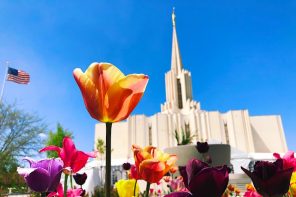This week, Utah and Idaho delivered Bernie’s largest margin of victories in the Democratic primaries since Vermont—with both giving him nearly 80 percent of the vote. The record turnouts in many Mormon-dominated precincts shocked onlookers and bewildered volunteer organizers, who continuously rushed to print more ballots after running out several times. In Utah, voting lines stretched around several city blocks, districts that were used to double-digit numbers were overwhelmed with thousands of participants, and the vast majority were adamant Sanders supporters. The night was unprecedented in the modern Mormon world.
Are you "Mormon Bernin'"?
Utahns line up to hear @BernieSanders speak in Salt Lake Cityhttps://t.co/C0qmU3mgFw pic.twitter.com/xhnlGs9m1T— The Salt Lake Tribune (@sltrib) March 18, 2016
Close observers expected the “Mormon Vote” to go Sanders’s way—the latest polling had him up eight points, Sanders held huge rallies in both states, and Hillary Clinton didn’t even hold any events in the area—but these were much larger margins than even the most pro-Bernie fans could have expected. This likely won’t be Sanders’s springboard to a national victory though, as he also lost the biggest prize of the night, Arizona. But Idaho and Utah granted more validity to Sanders’s continued campaign, especially going into the western states’ primaries where he is expected to demonstrate the appeal of his national movement.
“Charting the progressive components of the Mormon Church’s founding decades not only displays a road not taken, but also potential tools to construct future roads not yet realized.”
It also validates a lingering progressive strain within the Mormon tradition. The Church of Jesus Christ of Latter-day Saints has come to be seen as synonymous with the Republican Party—the most recent Pew Report showed that Mormonism was the most Republican religion in America—but that hasn’t always been the case.
Utah’s alignment with the conservative movement had its origins in the early twentieth century when prominent leaders came out in support of the Republican Party, yet it was far from determined; the state voted for Franklin D. Roosevelt four times, for instance. But the coalescing of the culture wars, the demise of the few Mormon leaders who publicly leaned progressive, and the general demographic trends of the region overcame a trajectory that never took shape and cultivated the now-familiar conservative image. Mormonism’s Republican identity is mostly a creation of recent vintage.
Like most religious traditions, there are both conservative and progressive elements within Mormonism’s faith and history, cultural products that can be molded according to the will of historical actors. Proponents of the Mormon Right emphasize personal responsibility, traditional social values and economic independence. But charting the progressive components of the Mormon Church’s founding decades not only reveals a road not taken, but also tools to construct roads not yet realized. Indeed, an emphasis on shared economic responsibility and strong federal protections for minority groups were dominant Mormon political concerns during the life of Joseph Smith, the founder of the Church.
The early Mormon movement in the antebellum period was as much a social protest as it was a religious revival. Part of a large component of American society disillusioned with the democratization and industrialization of America during the nation’s first half-century, Mormonism drew from cultural segments that believed economic success had become too fleeting and democratic practices too chaotic.
The Book of Mormon included passages that commanded believers to “succor those that stand in need of your succor,” and demanded them not to “suffer that the beggar putteth up his petition in vain” (Mosiah 4:16). One of the anti-Christs of the text was condemned for preaching that “every man prospered according to his genius, and that every man conquered according to his strength” (Alma 30:17)—a repudiation of the supposed American dream based on Franklinian principles. Religious utopia in the scriptural book was achieved when society “had all things in common” (4 Nephi 1:3), and was destroyed with the reestablishment of private ownership and the prevalence of wealth inequality.
“As religious minorities, they believed that in order to enjoy the “blessings and privileges of an American citizen,” America required a vigorous centralized government that was powerful enough to overturn state injustices.”
Converts to Mormonism in America and England streamed in from the poor and disfranchised classes, and to solve their financial burdens Smith implemented a complex and communitarian system of property redistribution called “The Law of Consecration.” “If ye are not equal in earthly things,” one of Joseph Smith’s revelations bellowed, “ye cannot be equal in obtaining heavenly things” (Doctrine and Covenants 78:6). Smith—who himself came from a family that faced immense financial troubles—chastised one of his clerks for emphasizing personal property, and claimed that since “all things are the Lord’s,” they were merely “privileged with using them.”
This communal perspective was even echoed by Brigham Young, who once declared, “I have heard the Elders say they were not dependent on any man…[but] I consider that we are all dependent one upon another for our exaltation and that our interest is inseparately connected.” This was a critique of both the Age of Individualism as well as the developing capitalistic order. These communitarian orders only intensified throughout the nineteenth century.
When Mormons were driven from their first settlements in Ohio and Missouri—in part due to their refusal to participate in the economic systems in both places—they increasingly turned to the federal government as their method of political salvation. As religious minorities, they believed that in order to enjoy the “blessings and privileges of an American citizen,” America required a vigorous centralized government that was powerful enough to overturn state injustices.
In 1844, Smith corresponded with presidential hopeful John C. Calhoun, the architect of the South’s states’ rights doctrine, and asked what he would do to help minority groups like Mormons. After he received the unsatisfactory response that the federal government only has “limited and specific powers,” Smith chastised the politician for failing to grasp the necessity of federal responsibility. This “fragile view” of the Constitution that emphasized state control was a betrayal of the nation’s founding principles. “The states rights doctrine,” Smith reasoned, was “what feeds mobs.”
The Mormon prophet then ran as a protest candidate for the American presidency, a counter to the feeble status quo. Among his quixotic platform that included the annexation of Texas, the end of slavery through compensation to slave owners, and more sympathetic laws toward debtors—his own family, after all, had faced the harsh realities of debtors’ laws—was a firm belief in the centralization of federal power in defense of minorities’ rights. He wanted to trumpet, as he outlined to Calhoun, “the sublime idea that Congress, with the President as executor, is as Almighty in its sphere as Jehovah is in his.” His belief that “unity is power,” as outlined in his presidential platform, necessitated a strong federal apparatus that could overrule state dissent. Only in such a political system could an average citizen’s rights be maintained.
These were strong political critiques lobbied from the margins of society. Even polygamy—their infamous marital experiment—was framed as a form of social protest against prevailing domestic norms. Yet as society, both within and without the Mormon region, evolved—so too did Mormonism’s dominant political message. Once settled in the far western territories after 1850, the LDS Church chafed under federal control, and when Utah became financially stable in the twentieth century LDS culture embraced mainstream economic beliefs. Joseph Smith’s political protest became a remnant of a foreign past. But the artifacts are there to be discovered, perhaps to be organized into a new political display that has relevancy in the twenty-first century. In a way, the surprising Mormon support for Bernie Sanders is another exhibit in that long, paradoxical, yet powerful exposition.
There will be limits to this trend, at least in the short term. Unlike some pundits who consider this year to possibly mark a major transition in the Mormon vote, that’s far from likely. Sanders’s success in the Mormon region came at the expense of Clinton, who seems to have very little traction in either Utah or Idaho. Even though Mormon Republicans have made it clear that they are unwilling to support Trump—as outlined by McKay Coppins—a conservative write-in candidate may very well garner more votes in November than a Democratic ticket with Clinton as the nominee, at least in Utah. But this progressive tradition will remain smoldering beneath the ashes of contemporary Mormonism’s political culture, awaiting for the day when it might finally spark like tinder.





